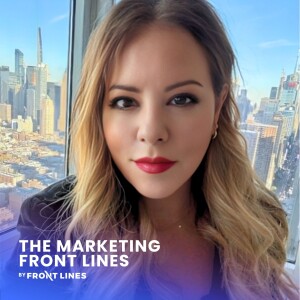Episodes

4 days ago
4 days ago
In this episode of The Marketing Front Lines, we s with Jessica Pratt, Director of Marketing and Communications at PeakMetrics. PeakMetrics is pioneering the narrative intelligence category, helping brands monitor and respond to emerging online conversations that can impact their reputation and bottom line. As the first marketing hire at this AI-driven startup, Jessica has built a relationship-first marketing strategy that breaks from traditional playbooks, focusing on authentic connections over mass outreach. Her approach leverages everything from lunch-and-learns to customer advisory boards, proving that even in an AI-saturated world, human connections drive the most meaningful business outcomes.
Topics Discussed:
Building relationship-driven marketing strategies in emerging categories
Leveraging founders and advisors as content creators and thought leaders
Creating customer advisory boards for product development and marketing amplification
Moving beyond traditional conference booth strategies to intimate networking
Using product insights as PR and relationship-building tools
Scaling content quality over quantity as a solo marketing team
Adapting traditional PR tactics for modern media consumption patterns
//
Sponsors:
Front Lines — We help B2B tech companies launch, manage, and grow podcasts that drive demand, awareness, and thought leadership.
www.FrontLines.io
The Global Talent Co. — We help tech startups find, vet, hire, pay, and retain amazing marketing talent that costs 50-70% less than the US & Europe.
www.GlobalTalent.co
//
Don't Miss: New Podcast Series — How I Hire
Senior GTM leaders share the tactical hiring frameworks they use to build winning revenue teams. Hosted by Andy Mowat, who scaled 4 unicorns from $10M to $100M+ ARR and launched Whispered to help executives find their next role.
Subscribe here: https://open.spotify.com/show/53yCHlPfLSMFimtv0riPyM

6 days ago
6 days ago
In this episode of The Marketing Front Lines, we speak with Jaimi Klein, Head of Marketing at STAX Engineering. STAX is an emissions capture and control company that treats exhaust emissions from cargo vessels when they're docked at ports worldwide. Operating in an emerging market where air quality regulations are driving demand, STAX faces the unique challenge of building credibility in an industry scarred by previous companies that made promises but failed to deliver. Through a "seeing is believing" marketing philosophy, strategic content development, and founder-led thought leadership, STAX is establishing itself as the real deal in maritime emission control technology.
Topics Discussed:
Overcoming industry skepticism in emerging cleantech markets
Building credibility through proof-of-concept demonstrations and third-party validation
Transitioning from paid advertising to organic content and PR strategies
Developing educational content for highly technical B2B audiences
Strategic founder positioning and thought leadership development
Growing LinkedIn presence from zero to significant engagement in 12 months
Working as a solo marketing team with agency and freelancer support
//
Sponsors:
Front Lines — We help B2B tech companies launch, manage, and grow podcasts that drive demand, awareness, and thought leadership.
www.FrontLines.io
The Global Talent Co. — We help tech startups find, vet, hire, pay, and retain amazing marketing talent that costs 50-70% less than the US & Europe.
www.GlobalTalent.co
//
Don't Miss: New Podcast Series — How I Hire
Senior GTM leaders share the tactical hiring frameworks they use to build winning revenue teams. Hosted by Andy Mowat, who scaled 4 unicorns from $10M to $100M+ ARR and launched Whispered to help executives find their next role.
Subscribe here: https://open.spotify.com/show/53yCHlPfLSMFimtv0riPyM

Thursday Jun 26, 2025
Thursday Jun 26, 2025
In this episode of The Marketing Front Lines, we speak with Diana Rabba, Head of Marketing at Exein, a cybersecurity company securing over 1 billion connected IoT devices globally. Diana shares her tactical approach to transforming cybersecurity marketing from the ground up, including how she achieved 300% organic traffic growth within her first few months through content strategy overhaul, building authority in a conservative industry, and navigating the long-game nature of B2B trust-building in highly regulated markets.
Topics Discussed:
Rebuilding content strategy from promotional to value-driven authority platform
Creating compelling branding in the traditionally conservative cybersecurity space
Building marketing teams: balancing in-house expertise vs external agency partnerships
Community building strategies for reaching CISOs and technical decision-makers
Achieving rapid organic growth through content pruning and strategic SEO
Positioning IoT cybersecurity in a heavily regulated, compliance-driven market
//
Sponsors:
Front Lines — We help B2B tech companies launch, manage, and grow podcasts that drive demand, awareness, and thought leadership.
www.FrontLines.io
The Global Talent Co. — We help tech startups find, vet, hire, pay, and retain amazing marketing talent that costs 50-70% less than the US & Europe.
www.GlobalTalent.co
//
Don't Miss: New Podcast Series — How I Hire
Senior GTM leaders share the tactical hiring frameworks they use to build winning revenue teams. Hosted by Andy Mowat, who scaled 4 unicorns from $10M to $100M+ ARR and launched Whispered to help executives find their next role.
Subscribe here: https://open.spotify.com/show/53yCHlPfLSMFimtv0riPyM

Wednesday Jun 25, 2025
Wednesday Jun 25, 2025
In this episode of Front Lines Marketing, we speak with Tara Bartley, Vice President of Marketing at REsurety, a provider of data, software and services to the clean energy economy. As the first dedicated marketing hire at the 65-person company, Tara built REsurety's entire marketing function from the ground up over nearly four years. Her journey from implementing basic marketing automation to developing sophisticated content multiplication strategies offers a masterclass in resource-efficient B2B marketing for fast-growing tech companies.
Topics Discussed:
Building marketing infrastructure and tech stack from zero at a growing company
Content multiplication philosophy: extracting maximum value from limited resources
LinkedIn strategy evolution and the shift from company to executive posting
Email marketing challenges and the move toward personalized communication
Measuring PR effectiveness and building relationships with specialized agencies
Team building philosophy focused on leveraging individual strengths rather than fixing weaknesses
Tactical Lessons For B2B Tech Marketers:
Master Content Multiplication at Scale: Rather than constantly creating new content, systematically extract maximum value from each piece. Tara's philosophy involves taking one expert-created asset (like a white paper from a subject matter expert) and transforming it into five different formats: infographics, LinkedIn posts, one-page briefs, webinar content, and email campaigns. This approach is particularly critical for resource-constrained teams where pulling technical experts away from their core work is expensive.
Prioritize LinkedIn Executive Content Over Company Pages: The data is clear - executive posts significantly outperform company page content on LinkedIn. People follow people, not brands. Tara's team saw measurable engagement differences when their CEO Lee Taylor posted versus the company account. The strategy involves at least three posts per week, team amplification through likes and shares, and strategic use of LinkedIn's promotion feature ($140 can generate 12,500+ impressions with strong ROI).
Avoid Arbitrary Marketing KPIs That Drive Mediocre Content: One of the most damaging practices in B2B marketing is setting calendar-based content schedules (monthly newsletters, weekly blog posts) without considering value delivery. Tara deliberately avoids sending newsletters just to hit a KPI, instead focusing on meaningful content that prevents subscriber fatigue and maintains engagement quality. This approach requires defending marketing strategy against internal pressure for consistency metrics.
Implement Strength-Based Team Building Using CliftonStrengths: Rather than trying to make team members well-rounded, identify their natural strengths and push them deeper into those areas. Tara uses CliftonStrengths assessments to understand her team's natural abilities - for example, her top strength of "winning others over" becomes a strategic advantage in client-facing marketing activities. Watch for tasks that consistently get pushed to the back burner as signals of misaligned responsibilities.
Establish Marketing as Strategy, Not Concierge Service: The most critical mindset shift for marketing leaders is refusing to drop everything for every random suggestion. As Tara learned from Akamai CMO Kim Salem-Jackson: "Marketing is not a concierge service." Successful marketing requires staying focused on planned strategy while maintaining flexibility for genuine pivots based on customer needs, not internal whims or competitor reactions.
Measure PR Through Multiple Value Streams: Public relations measurement goes beyond traditional media placements. Track earned media placements, blog post contributions, interview assistance, script development, and strategic guidance. Tara measures not just the three earned media placements her PR firm secured, but also their contributions to four blog posts and interview preparation support. This comprehensive measurement approach justifies PR investment and optimizes agency relationships.
//
Sponsors:
Front Lines — We help B2B tech companies launch, manage, and grow podcasts that drive demand, awareness, and thought leadership.
www.FrontLines.io
The Global Talent Co. — We help tech startups find, vet, hire, pay, and retain amazing marketing talent that costs 50-70% less than the US & Europe.
www.GlobalTalent.co
//
Don't Miss: New Podcast Series — How I Hire
Senior GTM leaders share the tactical hiring frameworks they use to build winning revenue teams. Hosted by Andy Mowat, who scaled 4 unicorns from $10M to $100M+ ARR and launched Whispered to help executives find their next role.
Subscribe here: https://open.spotify.com/show/53yCHlPfLSMFimtv0riPyM

Tuesday Jun 24, 2025
Tuesday Jun 24, 2025
In this episode of Marketing Front Lines, we speak with Maja Hamberg, Head of Marketing at Sixfold. Sixfold builds AI solutions for insurance underwriters, automating the manual document review process that slows down insurance applications. Operating in a market where buyers are still figuring out how to purchase AI solutions, Maja has developed a marketing playbook focused on radical simplicity, quality over quantity, and showing rather than telling. Her approach centers on two core channels - high-quality content and curated in-person events - while abandoning traditional B2B tactics like fancy email designs and social media breadth for authentic, human-centered marketing.
Topics Discussed:
Building marketing strategy for AI buyers still learning how to purchase
Transitioning from "should we buy AI?" to "which AI solution fits our needs?"
Developing messaging that cuts through AI buzzword fatigue
Creating intimate events that drive genuine business relationships
Balancing founder-led marketing with team scalability
Leveraging product demonstrations to overcome AI skepticism
Tactical Lessons For B2B Tech Marketers:
Focus on Two Channels and Execute Them Exceptionally: Rather than spreading resources across multiple marketing channels, Sixfold concentrates on content marketing and events, ensuring both reach exceptional quality standards. This means taking an extra month to perfect a blog post or report, and carefully curating guest lists and entertainment for events. The depth-over-breadth approach allows small marketing teams to compete with larger organizations by delivering superior experiences in focused areas.
Replace Complex Messaging with Human Simplicity: In AI marketing, avoid technical jargon and inflated claims like "100x efficiency gains" that prospects can't relate to or verify. Test all messaging with outsiders - friends, colleagues, or customers - asking specifically whether they understand what you do and who you serve. If the explanation requires additional context, simplify further. The goal is immediate comprehension, not impressive vocabulary.
Design Events for Relationship Building, Not Lead Generation: Structure dinner events around 12 people maximum to enable meaningful conversations, and carefully consider seating arrangements to connect attendees who should know each other. For larger happy hours (up to 200 people), maintain a strategic mix of partners, customers, and prospects rather than filling rooms with vendors. Skip presentations entirely - instead, introduce relevant industry topics as conversation starters and let organic discussions develop.
Abandon Designed Emails for Authentic Communication: Plain-text emails that sound like personal correspondence significantly outperform designed marketing emails in B2B contexts. Recipients are more likely to reply to messages that feel genuine, even when they recognize them as part of marketing campaigns. This shift requires letting go of design investments but delivers measurably better engagement and response rates.
Show Your Product Instead of Describing It: For technical products, especially AI solutions, demonstrations generate stronger reactions than explanations. Invest in video content, website product tours, and live demonstrations during sales conversations. The difference in prospect reaction between showing and telling is dramatic - "wow" versus "interesting" - making this approach essential for overcoming AI buzzword fatigue.
Structure Product Marketing Onboarding Around Technical Depth: When hiring product marketers for technical AI products, plan extensive product team collaboration in the first 90 days. The complexity of AI solutions requires deep technical understanding before effective messaging can develop. This investment in technical education pays dividends in more credible positioning and competitive differentiation.
//
Sponsors:
Front Lines — We help B2B tech companies launch, manage, and grow podcasts that drive demand, awareness, and thought leadership.
www.FrontLines.io
The Global Talent Co. — We help tech startups find, vet, hire, pay, and retain amazing marketing talent that costs 50-70% less than the US & Europe.
www.GlobalTalent.co
//
Don't Miss: New Podcast Series — How I Hire
Senior GTM leaders share the tactical hiring frameworks they use to build winning revenue teams. Hosted by Andy Mowat, who scaled 4 unicorns from $10M to $100M+ ARR and launched Whispered to help executives find their next role.
Subscribe here: https://open.spotify.com/show/53yCHlPfLSMFimtv0riPyM

Friday Jun 13, 2025
Friday Jun 13, 2025
In this episode of The Marketing Front Lines, we speak with Cristina Bunea, Head of Marketing at Paraform. With a unique background as a technical founder turned marketer, Cristina brings a refreshing perspective on creating distinctive B2B marketing that cuts through the noise. From building a magazine-quality blog that customers rave about to running experimental marketing campaigns that challenge conventional wisdom, Cristina shares the strategies that have defined her approach to B2B marketing. She reveals how her team at Command AI (formerly Command Bar) transformed their company blog into a weekend read that customers loved, and discusses her current work at Paraform creating deep-dive content that examines how successful companies operate.
Topics Discussed:
Transitioning from technical founder to marketing leader
Creating non-boring, crystal-clear B2B marketing
Building a magazine-quality blog that drives customer acquisition
Making strategic bets on experimental marketing initiatives
Managing the complex founder-marketer relationship
Using AI effectively in content creation workflows
Avoiding generic content in an LLM-saturated landscape
Lessons For B2B Tech Marketers:
Turn Your Blog Into a Weekend Read: At Command AI, Cristina's team created a blog that felt like a magazine - content so engaging that customers would read it on weekends, not just when prompted by work needs. This approach generated significant customer engagement, with roughly one in three customers specifically mentioning the quality of their content.
Experiment Strategically, Not Randomly: Run the marketing basics extremely well, then take calculated bets on 1-2 experimental initiatives per quarter. When Cristina attempted to replicate Ramp's microapps strategy at Command Bar, it flopped despite its success elsewhere, reinforcing that strategy must be tailored to your specific context.
Share Authentic Company POVs: The most successful content shares genuine insights about internal company operations - from sales approaches to customer success methodologies. This transparency resonates with audiences tired of generic advice and provides actionable intelligence they can adapt to their needs.
Create Deep-Dive Content on Companies People Care About: Content that analyzes how well-known companies operate (how they hire, how they acquired their first 100 customers) consistently performs well. At Paraform, Cristina's team creates detailed teardowns that examine specific tactics other companies use, providing readers with concrete examples they can learn from.
Manage Founder Relationships Through Calibration: Schedule weekly meetings with founders to understand their product philosophy and vision. Present multiple marketing options to help founders identify what matches their vision, as they often have clear ideas but struggle to articulate them. This prevents misalignment and builds trust.
Use AI as a Cold-Start Solution: Record meetings with founders, write your own notes with content ideas, then combine these with the transcript in an AI tool to generate initial drafts. While not perfect, this approach significantly reduces the time required to create founder-aligned content that can be further refined.
Combat Generic Content With Specificity: In an LLM-saturated world, generic marketing advice is everywhere. Stand out by sharing real insights others wouldn't think of, and ask yourself: "Have I seen this same content a hundred times on LinkedIn today?" If yes, don't publish it.
Hire Marketers Who Love Your Product: Technical understanding and genuine excitement about your product are non-negotiable traits in marketing hires. Without this foundation, even the most skilled marketers will struggle to create authentic, compelling content about your offering.
//
Sponsors:
Front Lines — We help B2B tech companies launch, manage, and grow podcasts that drive demand, awareness, and thought leadership.
www.FrontLines.io
The Global Talent Co. — We help tech startups find, vet, hire, pay, and retain amazing marketing talent that costs 50-70% less than the US & Europe.
www.GlobalTalent.co
//
Don't Miss: New Podcast Series — How I Hire
Senior GTM leaders share the tactical hiring frameworks they use to build winning revenue teams. Hosted by Andy Mowat, who scaled 4 unicorns from $10M to $100M+ ARR and launched Whispered to help executives find their next role.
Subscribe here: https://open.spotify.com/show/53yCHlPfLSMFimtv0riPyM

Thursday Jun 12, 2025
Thursday Jun 12, 2025
In this episode of The Marketing Front Lines, we speak with Levi Lindsay, VP of Marketing at Hona. Hona is revolutionizing legal client communication by creating "the pizza tracker for legal cases" - a platform that allows personal injury clients to track their case progress through an intuitive app interface. Operating in a market where lawyers handle contingency and flat-rate cases, Hona eliminates the redundant phone calls asking "where are we at on my case?" by providing automated case updates and educational content at each phase. Levi's unconventional journey from windshield repair to B2B marketing has shaped his approach to bringing D2C creativity and energy to the traditionally conservative legal tech space.
Topics Discussed:
Creating category demand when search volume doesn't exist for your product
Scaling marketing so effectively that sales can't keep up with inbound leads
Bringing D2C creative energy and tactics to conservative B2B industries
Using AI for competitive analysis and objection mining from sales call transcripts
Building viral moments within niche professional communities
Testing and killing marketing channels quickly based on data, not advice
Lessons For B2B Marketers:
Focus on Demand Generation Before Demand Capture: Instead of just scooping up existing demand, invest heavily in warming "hard nos" into "maybes" and "maybes" into "yeses." This approach prevents hitting growth walls when the pool of ready buyers gets exhausted. Create awareness through content and paid campaigns to ensure your funnel never runs dry.
Treat B2B Marketing Like D2C When Appropriate: Don't accept that B2B has to be boring. Create viral moments within your ICP community through bold conference activations, creative swag, and brand experiences that make people stop and stare. A fishbowl head with live fish at a legal conference gets more attention than any traditional booth setup.
Leverage Meta for Professional Audiences Who Live There: While LinkedIn seems like the obvious choice for B2B, research where your ICP actually spends time. Personal injury lawyers and their staff live on Facebook and Instagram because that's where they acquire their clients, making Meta surprisingly effective for reaching legal professionals.
Use AI for Competitive Intelligence Mining: Feed all your sales call transcripts into ChatGPT to identify patterns in objections, feature requests, and buyer concerns. This transforms hours of manual analysis into actionable insights about your ICP's real pain points and decision-making criteria.
Test Everything, Trust Data Over Expert Advice: Even respected industry experts can be wrong about what works for your specific situation. A VP's advice against paid ads could cost you hundreds of thousands in monthly revenue. Run small tests quickly, kill what doesn't work fast, and scale what performs regardless of conventional wisdom.
Create Conference Moments That Demand Attention: In conservative industries, nobody pushes creative boundaries, which creates massive opportunities. Build neon booths, create interactive installations, and design experiences that make your brand impossible to ignore. Ask for forgiveness rather than permission when pushing creative limits.
Solve for Category Creation Through Problem-First Messaging: When search volume doesn't exist for your solution, lead with the problem presentation rather than solution explanation. Show the pain point first, let prospects self-identify, then introduce your solution as the obvious answer to their recognized problem.
//
Sponsors:
Front Lines — We help B2B tech companies launch, manage, and grow podcasts that drive demand, awareness, and thought leadership.
www.FrontLines.io
The Global Talent Co. — We help tech startups find, vet, hire, pay, and retain amazing marketing talent that costs 50-70% less than the US & Europe.
www.GlobalTalent.co

Friday Jun 06, 2025
Friday Jun 06, 2025
In this episode of The Marketing Front Lines, we speak with Kevin Allen, Head of Marketing at ValidMind. Kevin's journey from Chicago Sun-Times journalist to startup marketing leader offers unique insights into building content-driven marketing programs at scale. At IBM, he transformed a $600,000 content budget into a zero-cost internal creator program by mobilizing technical employees as brand evangelists. Now at ValidMind, an AI governance platform for financial institutions, Kevin applies these same principles to establish thought leadership in the rapidly evolving model risk management space.
Topics Discussed:
Building Internal Content Machines at Enterprise Scale Kevin led IBM's transformation from external content spend to internal creator mobilization, managing the rebrand of a 20-year-old Developer Works platform while maintaining SEO equity and customer access to legacy content.
Scaling Technical Eminence Programs How IBM created systematic programs to boost individual visibility and credibility, turning technical employees into brand evangelists through performance review integration and content quality dashboards.
Transitioning Brand Publishing to Startups Kevin's approach to applying enterprise-level content strategies at ValidMind, focusing on thought leadership in AI governance and model risk management for financial institutions.
Journalist-to-Marketer Career Transition The tactical advantages of journalistic training in marketing roles, including research methodologies, interviewing techniques, and content creation processes that transfer across industries.
Improvisation as Professional Development How improv comedy principles, particularly "yes, and" thinking, enhance creative collaboration and ideation in marketing teams and campaign development.
Lessons For B2B Tech Marketers:
Transform Budget Constraints into Scaling Opportunities When Kevin's IBM content budget was eliminated, he didn't reduce output—he restructured the entire program around internal creators. By integrating content creation into employee performance reviews and tying it to technical eminence goals, he maintained quality and volume while building a sustainable, scalable system. This approach works particularly well in technical organizations where employees have deep expertise but need support with content creation and promotion.
Create Content Quality Infrastructure Before Scaling IBM's success came from building sophisticated measurement systems before expanding their internal creator program. They developed content performance dashboards, author effectiveness metrics, and content lifecycle management processes. This infrastructure allowed them to identify top performers, optimize content quality, and systematically refresh or deprecate outdated material—preventing the common problem of scaling content quantity at the expense of quality.
Use Ghostwriting as Executive Relationship Building Kevin's journalism background enabled him to conduct structured interviews with technical executives and transform their expertise into consumable content. This ghostwriting approach served dual purposes: creating high-quality thought leadership content while building trust and respect with senior stakeholders who became program champions. For marketers without journalism backgrounds, developing strong interviewing and synthesis skills can unlock similar opportunities.
Apply Journalist Research Methodologies to New Industries Kevin's framework for entering new markets mirrors journalistic beat reporting: identify key players, understand trends and opportunities, analyze competitive approaches, and build knowledge systematically. This structured approach accelerates market understanding and credibility building, particularly valuable for marketers transitioning between industries or companies entering new market segments.
Integrate Creative Collaboration Principles into Campaign Development The "yes, and" improv principle Kevin teaches creates more dynamic brainstorming sessions and campaign ideation. Unlike traditional feedback loops that can stall creative momentum, this approach builds ideas collaboratively while maintaining forward progress. The contrast Kevin demonstrates between "yes, and" versus "no, but" sessions shows measurable differences in creative output and team engagement.
Position Thought Leadership as Customer Education Strategy At ValidMind, Kevin frames content marketing as customer education rather than product promotion, particularly effective in rapidly evolving technical spaces like AI governance. By establishing the company as the smartest voice in model risk management, they create strategic advantage through education rather than direct selling—especially powerful when regulations and best practices are still emerging.
//
Sponsors:
Front Lines — We help B2B tech companies launch, manage, and grow podcasts that drive demand, awareness, and thought leadership.
www.FrontLines.io
The Global Talent Co. — We help tech startups find, vet, hire, pay, and retain amazing marketing talent that costs 50-70% less than the US & Europe.
www.GlobalTalent.co

Tuesday Jun 03, 2025
Tuesday Jun 03, 2025
In this episode of The Marketing Front Lines, we speak with Alex McEachern, Head of Marketing at Intelligems. Alex brings a decade of B2B marketing experience in the e-commerce space, having witnessed the evolution from early content marketing tactics to today's sophisticated, personality-driven strategies. Through his journey from accidentally landing in marketing to leading content strategy at a fast-growing e-commerce testing platform, Alex shares tactical insights on modern content creation, the death of traditional lead magnets, and why B2B buyers behave exactly like consumers.
Topics Discussed:
The evolution and failure of traditional lead magnets in modern B2B marketing
Building founder-led content strategies without gating valuable information
Leveraging social algorithms while avoiding platform penalties for external links
Creating zero-click content that builds brand awareness without direct CTAs
Developing unique podcast angles that emotionally engage prospects
The psychology of B2B buyers and why they mirror consumer purchasing behavior
Narrative positioning strategies that avoid problem-focused messaging
Lessons For B2B Tech Marketers:
Abandon Gated Content Strategies Completely: Traditional lead magnets with gated content are not just ineffective—they're counterproductive. Alex advocates for making all expertise publicly available rather than trading contact information for content. The new "lead magnet" equivalent is high-value experiences like exclusive events or conferences that justify the contact information exchange.
Master Platform-Native Content Distribution: Social algorithms actively suppress posts with external links. Instead of driving traffic off-platform, create zero-click content that delivers full value within the social platform itself. Let prospects search for your brand when they're ready rather than forcing immediate action. This approach generates significantly higher reach and creates a content ecosystem that builds brand awareness.
Use Multi-Voice Content Remix Strategies: Rather than relying solely on founder-led content, establish 3-4 key voices across the organization (founders, head of marketing, head of go-to-market). Create one piece of core content, then remix it across these different voices with unique perspectives. This multiplies content output while maintaining consistent messaging and creates multiple touchpoints for prospects.
Build Tangential Content That Creates Emotional Engagement: The most effective B2B content sits adjacent to your product rather than directly describing it. Alex's previous "Customer Hat" podcast never mentioned their retention software but explored how brand owners actually shop, revealing the disconnect between their advertising strategies and personal buying behavior. This tangential approach draws new audiences who wouldn't engage with product-focused content.
Treat B2B Buyers as Multi-Dimensional Humans: B2B buyers use the same emotional decision-making processes as consumers. They buy on emotion, find solutions through research, then rationalize with logic. Create content that acknowledges buyers as complete people—not just professional personas—by mixing business insights with personal interests and humanizing moments.
Position Solutions as Barrier Removal, Not Problem Identification: Avoid the common B2B trap of leading with problems, which immediately raises buyer defenses. Instead, position your solution as removing barriers that prevent buyers from achieving their goals. Frame the narrative around enabling capabilities rather than fixing deficiencies. This creates a collaborative rather than accusatory dynamic.
//
Sponsors:
Front Lines — We help B2B tech companies launch, manage, and grow podcasts that drive demand, awareness, and thought leadership.
www.FrontLines.io
The Global Talent Co. — We help tech startups find, vet, hire, pay, and retain amazing marketing talent that costs 50-70% less than the US & Europe.
www.GlobalTalent.co

Tuesday Jun 03, 2025
Tuesday Jun 03, 2025
In this episode of The Marketing Front Lines, we speak with Lisa O'Reilly, Vice President of Marketing at iVerify. iVerify is pioneering mobile endpoint detection security, providing advanced protection against real threats that face all mobile devices, including both iOS and Android. As the first full-time marketing hire at the company, Lisa has built a marketing program from the ground up in one of the most crowded and competitive markets in tech. Through research-driven content marketing, strategic event approaches, and disciplined brand positioning, she's developed playbooks for standing out in the cybersecurity space while building authentic authority and trust within the mobile security community.
Topics Discussed:
Building marketing programs as the first marketing hire at a cybersecurity startup
Leveraging founder-led research and thought leadership for authentic brand building
Evolving event strategies from large-scale booth presence to curated, high-value meetings
Using AI tools to enhance marketing effectiveness and social media engagement
Developing disciplined content strategies that build category authority
Transitioning from product-focused to human-centered cybersecurity marketing
Lessons For B2B Tech Marketers:
Start With Deep ICP Analysis and Continuously Refine It: O'Reilly emphasizes that understanding your ideal customer profile isn't a one-time exercise. She rebuilt her buyer's journey and ABM program after her first year and continues to revise lead scoring models. This ongoing refinement ensures marketing efforts stay focused on prospects that actually convert, rather than chasing vanity metrics in an increasingly noisy market.
Leverage Authentic Research as Your Differentiation Engine: Rather than competing on messaging alone, iVerify built their marketing around proprietary research and threat discovery. Their "Data in the Middle" report became a conversation starter at RSA, opening doors that traditional marketing tactics couldn't. The key is ensuring research is genuinely valuable to the community, not just thinly veiled product promotion.
Abandon Large-Scale Events for Curated Relationship Building: O'Reilly shifted from expensive booth strategies at major conferences like RSA and Black Hat to hosting smaller, targeted meetings away from the event floor noise. This approach delivered better ROI through meaningful conversations and pipeline development, while avoiding the commoditized messaging that plagues large security conferences.
Use AI as a Creative Partner, Not a Replacement: O'Reilly discovered that AI-assisted social media content consistently outperformed her organic posts in terms of engagement. Rather than using AI for complete content creation, she leverages it to expand her initial ideas from three concepts to six or seven, then selects the best options. This approach maintains authenticity while enhancing creative output.
Build Authority Through Disciplined Topic Focus: In cybersecurity's crowded landscape, O'Reilly maintains strict discipline about which conversations to join. Rather than chasing every trending topic, iVerify focuses on mobile security expertise and consistently says no to adjacent opportunities. This focused approach builds genuine category authority over time.
Transition From Product-Centric to Human-Centric Narratives: O'Reilly's career evolution from commodity tech marketing to cybersecurity reflects a broader shift toward storytelling that emphasizes human impact. She can now tell stories about protecting infants in ICU units from threat actors, transforming cold product features into compelling narratives about saving lives and protecting organizations.
//
Sponsors:
Front Lines — We help B2B tech companies launch, manage, and grow podcasts that drive demand, awareness, and thought leadership.
www.FrontLines.io
The Global Talent Co. — We help tech startups find, vet, hire, pay, and retain amazing marketing talent that costs 50-70% less than the US & Europe.
www.GlobalTalent.co

